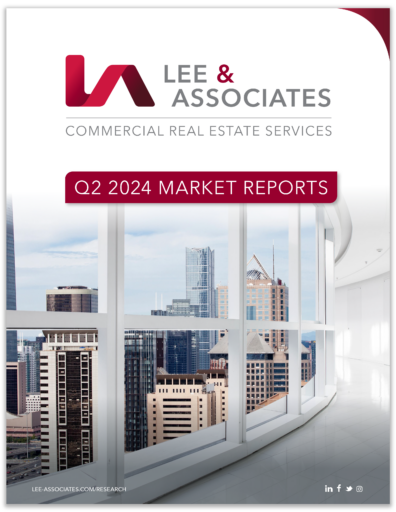INDUSTRIAL OVERVIEW: ACTIVITY, GROWTH CHECKED BY HIGH INTEREST RATES
Industrial market performance across North America continued to downshift in the first half. Although net absorption remains positive, demand for industrial space has fallen to the lowest levels in years as higher interest rates to reduce inflation also slows economic growth.
Net absorption in the United States totaled 23.9 million SF in the first two quarters. It was down from 80.3 million SF for the same period a year ago and is on pace for the slowest annual growth since the recession. Last year net absorption totaled 172.7 million SF, a sharp drop from the 940-million-SF of pandemic-fueled growth in 2021-2022. Otherwise, growth for the decade since the recession has averaged 240 million SF a year.
The recent contraction coincides with a series of 11 interest rate hikes by the Federal Reserve from March 2022 to July 2023, increasing the cost of federal funds from 0.25%-0.50% to 5.25%-5.50%. Inflation measured by the Consumer Price Index was down from a high of 9.1% in June 2022 to 3.3% in May. The U.S. GDP slowed to 1.4% in Q1 from a Covid-era peak of 5.8% in 2021.
The Fed’s rate increases have been tied partly to the 12-year low in home sales, depressing sales of furniture, appliances and building materials. This has forced the closure of some large distribution centers. Ashley Furniture, Home Depot and manufacturer Daltile all have closed facilities larger than 500,000 in 2024. Motivational Fulfillment, NFDI Industries and 3G Distribution Services have put big boxes up for sublease in major port markets this year. UPS plans to close 200 distribution centers globally through 2028 as it consolidates operations in its most automated facilities.
Not all merchants are backpedaling. Burlington Coat Factory, TJX Companies, Chuck and Dwight and Nestle USA have signed leases larger than 700,000 SF this year. READ MORE >
OFFICE OVERVIEW: WEAK DEMAND PLAGUES U.S. MARKETS
The United States and Canada share a long geographic border, but when it comes to office markets the two nations are in different worlds. There’s been healthy demand for space in Canada lately, but weak net absorption continues to dog U.S. markets, driving up the vacancy rate to a record 13.9%.
Negative net absorption in the U.S. in the first half totaled 28.4 million SF, a 28% improvement from the same period a year ago. Notably, although Q2 was the eighth straight quarter with demand in the red, it only totaled negative 1.6 million SF. It was the type of quarterly report that may give some landlords and investors hope that the market is bottoming.
Nevertheless, since April 2020, U.S. negative absorption totals more than 206 million SF, which is four times the occupancy lost in the 2008 financial crisis and nearly three times the loss after the dot-com bust. Stagnating office attendance, slowing office job growth and about 25% of pre-Covid leases yet to expire give little indication that reversal of the trend is imminent.
U.S. office attendance averages perhaps 5 percentage points higher than a year ago, according to independent surveys by Kastle Systems and Stanford University. When that is combined with slowing growth of less than 1% for office jobs, it results in space requirements continuing to resettle downward with many tenants shrinking in place or consolidating into fewer locations as leases expire.
Over the last 18 months the amount of space taken by new tenants is 15-20% less than the average from 2015-19. The volume of sublease space has doubled since 2019 to 200 million SF, half of which is vacant.
New construction is down with 10 million SF of new inventory added in the first half, the least since 2013. But about 18 million SF are slated for delivery in the third quarter. Starts totaled 4 million SF in Q1. The nearly 35 million SF in 2023 starts were the least since 2010. READ MORE >
RETAIL OVERVIEW: STRONG MERCHANT DEMAND CONTINUES
Record low vacancy and availability combined with a cooling economy is working against retail tenant expansion in the United States. But in Canada, merchants shrugged off a slower economy and stepped up growth in the first half, producing a 23% increase in year-over-year net absorption and driving down the nation’s vacancy rate to 1.5%, a new low.
The U.S. vacancy rate was unchanged at 4.1% at the end of Q2 and up slightly from the record 4% rate at the close of 2023. Demand for U.S. retail space rose by more than 51 million SF in 2023 for the third straight year of growth. But through June of this year absorption totaled only 9.9 million SF, down more than half from the same period a year ago.
Most recent growth has been driven by tenants from food-and-beverage, discount, health and beauty, off-price and experiential sectors. Food-and-beverage sector tenants accounted for nearly 20% of all leasing activity. Most of the focus is spaces of 2,500 SF or less and overwhelmingly is driven by growth from quick-service restaurants.
Meanwhile, new retail development activity in the U.S. remains minimal with only 18 million SF delivered in the first half. About 50 million SF of space was completed last year, which is nearly 40% less than the 10-year average.
Since early 2020, there has been more than 210 million SF of net absorption in the U.S. At the close of Q1 2024 only 739 million SF were available, nearly 15% less than the prior five-year average. Merchants leased up 205 million SF in 2023, the least since 2000, but the decline is more about lack of supply than slowing demand. The median length of time to lease available space has fallen to slightly less than eight months, the fastest since 2008. READ MORE >
MULTIFAMILY OVERVIEW: STRONG NORTH AMERICAN DEMAND
Canadian renters should be forgiven, when reflecting on the United States’ current multifamily market, if there is a twinge of tenant envy. In Canada, tough real estate development restrictions and liberal immigration policies are under fire for driving up the cost of housing. Following two years of near double-digit rent growth, the average nationwide vacancy rate is down to 2%, a two-decade low, amid record-setting population increases.
On the other hand, the U.S. multifamily market experienced a robust rebound in demand in the first half, driven by rising consumer confidence and diminishing recession fears. First-half net absorption totaled 287,635 units, 56% more than for the same period last year.
Despite the heightened demand new supply continues to saturate the market. There were 335,872 units added in the first half, including a quarterly record 182,872 in the second quarter. This surge in supply has pushed up the vacancy rate to a record 7.9%. But with absorption on the rise, the overall market is expected to stabilize and improve by the end of the year.
Detailed vacancy data reveals divergent trends among property segments. Vacancy in Class A properties have escalated over the last 10 quarters. A surplus of premium-level units has driven up the vacancy rate for the high-end segment by 440 basis points in this cycle to 11%. Reduced demand for Class B apartments – attributed to elevated prices and economic uncertainty – has resulted in a more modest vacancy increase of 300 basis points. Vacancy rates among mid-priced properties have ranged from 4.2% in 2021 to the current 7.1% in the second half.
As the vacancy rate has increased by 310 basis points since 2021, multifamily rent growth has fallen from 9.4% to 1.1%. But performance can vary widely from region to region and not all markets posted increasing vacancies. In fact, vacancies declined in six markets – San Francisco, East Bay, Louisville, Norfolk, San Jose and Orange County – as net absorption outpaced new supply. READ MORE >




